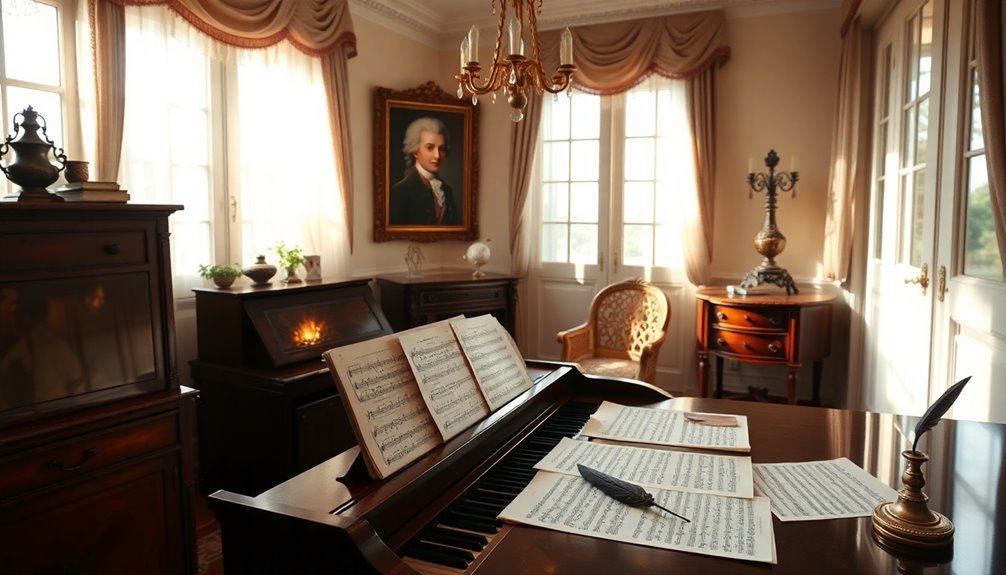You're about to discover the brilliance of Wolfgang Amadeus Mozart, born in 1756 in Salzburg, Austria. From a young age, he showcased his musical talents, playing harpsichord at four and composing by five. His early exposure to diverse styles shaped his expansive repertoire of over 600 works, including masterpieces like *The Marriage of Figaro* and *Symphony No. 40*. Despite facing financial struggles and personal challenges, his innovative compositions laid the foundation for future musicians. Mozart's influence is still felt today, enthralling audiences across genres. Continue on to uncover more fascinating details about his life and legacy!
Key Takeaways
- Born in 1756 in Salzburg, Mozart displayed prodigious musical talent, composing and performing from a very young age.
- His extensive body of work includes over 600 compositions, covering operas, symphonies, and concertos, showcasing his versatility.
- Notable operas like *The Marriage of Figaro* and *Don Giovanni* reflect his innovative approach to musical storytelling and character development.
- Despite personal and financial challenges, he maintained a prolific output, influencing future composers and shaping Western classical music.
- Mozart's harmonic innovations and emotional depth set lasting standards, making his works timeless staples in music education and performance.
Early Life and Family Background
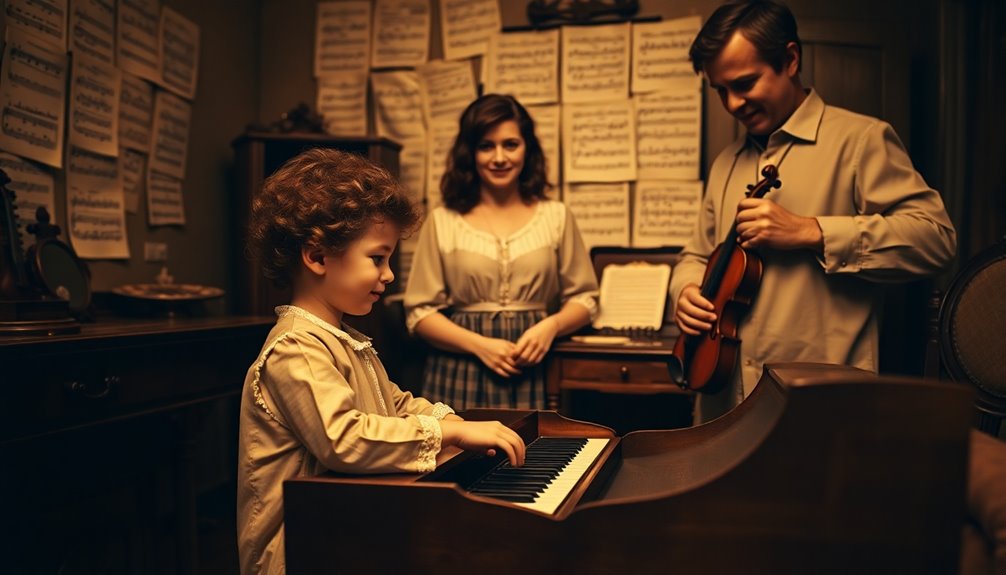
Born into a musical family on January 27, 1756, in Salzburg, Austria, Wolfgang Amadeus Mozart's early life was profoundly shaped by his father, Leopold, a composer and music educator. Leopold not only served as the deputy Kapellmeister at the prince-archbishop's court but also guaranteed that his children received a well-rounded education in music, languages, and academics. His mother, Anna Maria Pertl, supported this musical upbringing, traveling with Wolfgang and nurturing his talents.
As the youngest of seven children, Wolfgang shared a close bond with his sister, Maria Anna, affectionately known as Nannerl. She, too, displayed remarkable musical talent, taking keyboard lessons at an early age. Wolfgang would often observe her, mimicking her playing and developing his skills. The Mozart family, rooted in a legacy of artisans and musicians, created an environment rich in creativity. Their family tours exposed them to diverse musical styles, allowing Wolfgang to absorb various influences that would later enrich his compositions.
Leopold recognized and nurtured Wolfgang's extraordinary gift early on, laying the foundation for his future success. This unique combination of familial support and educational influence set the stage for the prodigious talent that would later captivate the world.
Musical Talent and Prodigy

From a remarkably young age, Wolfgang Amadeus Mozart showcased extraordinary musical talent that would soon astonish audiences across Europe. By just four years old, you'd find him playing the harpsichord, and by five, he was composing simple pieces. His musical journey accelerated rapidly; by age six, he was already performing as both a keyboard player and composer.
During his formative years, he toured Europe with his sister Nannerl and father Leopold, enchanting royal families and garnering admiration from musical greats like Johann Christian Bach. Here are key milestones that highlight his prodigious talent:
- Composed his first real operas, including "Bastien und Bastienne," by age 12.
- Created over 600 works, covering a wide range of genres, by adulthood.
- Transcribed Allegri's "Miserere" from memory during a visit to the Vatican in 1770.
- Gained a reputation as a mature composer by the age of 10.
Mozart's early mastery of music laid the foundation for his later groundbreaking contributions, firmly establishing him as a musical prodigy whose influence resonates even today. His remarkable ability to memorize complex choral music enabled him to transcribe intricate compositions, showcasing his unparalleled skill even at a young age.
Salzburg Career Beginnings

In Salzburg, you'll find the roots of Mozart's remarkable career, where his early musical training laid the foundation for his prodigious talent. As he performed across Europe, his compositions began to make a significant impact, showcasing his genius. This period marked the beginning of a journey that would transform the world of classical music. During this time, he was influenced by Salzburg's cultural scene, which played a crucial role in shaping his musical style.
Early Musical Training
Although he was born into a musical family, Mozart's extraordinary talent quickly set him apart. His father, Leopold Mozart, recognized his son's gift early on and began teaching him the basics of music at just four years old. By the age of five, you'd see him reading and writing music, performing on the keyboard with impressive skill.
During his early musical training, he mastered several instruments and developed a unique style. Here are key highlights from this formative period:
- Instrument Proficiency: He learned to play the piano, organ, viola, harpsichord, and violin, showcasing his versatility.
- Early Compositions: By six, he was already composing, with his first pieces recorded in the *Nannerl Notenbuch*.
- Performance Skills: Known for his improvisation, he dazzled audiences at concerts, enchanting them with his creativity.
- Court Musician: In 1773, he became a court musician under Prince-Archbishop Hieronymus Colloredo, where he began composing various genres, including symphonies and operas. His early exposure to music significantly contributed to his exceptional skills and compositions.
These early experiences laid the foundation for a career that would redefine classical music.
Prodigy Performances in Europe
Mozart's prodigious talent quickly captured the attention of Europe, leading to a series of remarkable performances that showcased his extraordinary abilities. In 1762, he and his sister Nannerl performed at Schönbrunn Palace in Vienna for the imperial court. They captivated Maria Theresa and her children, earning 100 gold ducats and 450 guilders, along with embroidered clothes from the royal family. During this memorable performance, young Mozart even playfully announced his intention to marry Archduchess Marie-Antoinette.
The following year, the Mozart family set out on a grand tour that lasted three years, visiting cities like London, Paris, and Munich. They performed for notable figures, including George III and Louis XV, receiving widespread acclaim. Along the way, Mozart met influential musicians like Johann Christian Bach, which enriched his musical journey. Mozart's early works were influenced by these encounters, shaping his unique style that would later define classical music.
Despite facing health challenges, including illnesses during their travels, Mozart continued to impress audiences with his solo and ensemble performances. He even published his first composition, a violin sonata, in 1764. Through these early concerts, Mozart laid the groundwork for his future success, establishing himself as one of Europe's most remarkable musical prodigies.
Salzburg Compositions and Impact
During his early years in Salzburg, Mozart produced a prolific body of work that greatly shaped his musical identity. Employed by Prince-Archbishop Hieronymus Colloredo, he navigated a complex relationship with his patron while honing his craft. His various roles, from concertmaster to court organist, allowed him to explore different musical genres and styles, leading to significant compositions.
Here are some key aspects of his Salzburg compositions:
- Diverse Genres: He composed symphonies, sonatas, string quartets, masses, and operas, showcasing his versatility.
- Violin and Piano Concertos: Between 1775 and 1777, he developed a passion for concertos, producing five violin concertos and shifting to piano concertos, including the notable E♭ concerto K. 271.
- Sacred Works: His sacred music, influenced by Baroque masters like Bach and Handel, included pieces like the "Coronation" Mass and the *Exsultate jubilate*. His compositions during this time were recognized and celebrated, earning him knighthood by the Pope.
- Symphonic Development: His early symphonies, such as Symphony No. 14 and No. 25, reflected his evolving mastery of orchestration and form, merging Baroque and Classical elements.
This period set the stage for his later achievements and enduring legacy in music.
European Tours and Performances
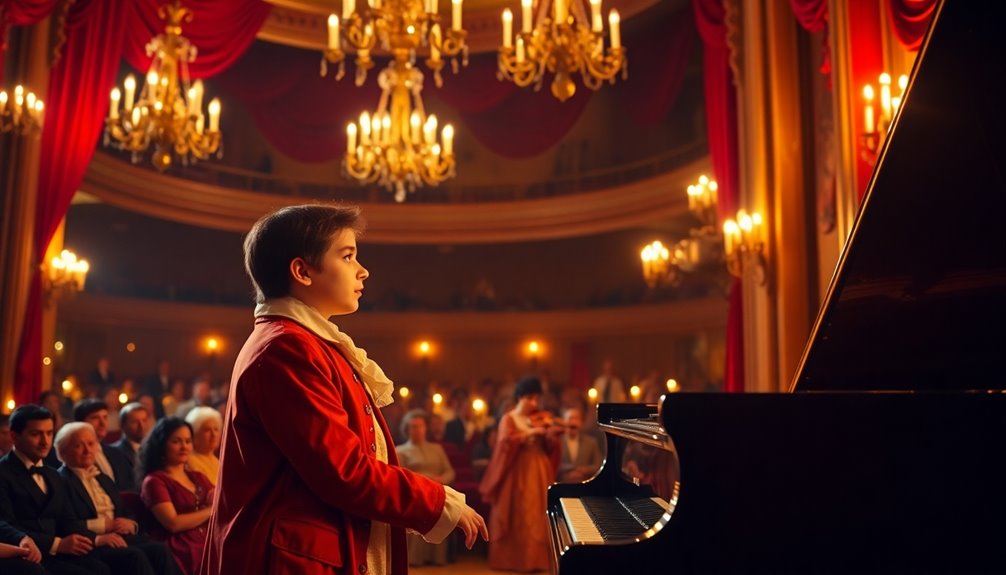
In the vibrant world of 18th-century Europe, the Mozart family began an extraordinary Grand Tour from 1763 to 1766, showcasing the exceptional musical talents of their children. Initiated by Leopold, this three-year journey took you through Austria, Germany, the Netherlands, France, England, and Switzerland. You performed at royal courts, including the Imperial Court in Vienna and for King George III in London, where Wolfgang composed his first symphonies.
In Munich, you captivated Elector Maximilian III, earning half of Leopold's annual salary. Your five-month stay in Paris allowed you to befriend leading figures and perform at the royal court. In London, where you spent over a year, Wolfgang composed three piano sonatas dedicated to Queen Charlotte, while also performing for the royal couple. Despite facing illnesses during the tour, you showcased resilience, even performing in The Hague.
This Grand Tour not only earned you significant income, like 200 florins in Mainz, but also established your family's reputation as musical prodigies. You absorbed diverse musical influences, including meeting Johann Christian Bach, which profoundly impacted Wolfgang's compositions. This journey laid the groundwork for the extraordinary career that awaited, ultimately contributing to Wolfgang's rise as a leading composer in Europe.
Move to Vienna

As Wolfgang and his family arrived in Vienna in 1781, they found themselves at a pivotal moment in his career. Summoned by Archbishop Colloredo for the coronation of Joseph II, Wolfgang quickly realized that Vienna offered more than just an event. After his dismissal from his Salzburg position, he faced a decision: to return or stay. The allure of better career opportunities and higher earnings than the 150 florins per year in Salzburg was tempting. Most importantly, his desire to compose operas, which Salzburg rarely supported, pushed him to stay.
In Vienna, Wolfgang experienced a mix of challenges and successes:
- He initially struggled financially, despite his growing fame.
- He had quarrels with Archbishop Colloredo, leading to his dismissal from service.
- He began composing significant works, including piano concertos and operas.
- He found support from Emperor Joseph II, paving the way for future successes.
Additionally, Vienna was a cultural hub for music and arts during the classical period, which greatly influenced his creative process.
Ultimately, this move transformed his life, marking Vienna as the center of his creative output until his untimely death. It was here that he produced masterpieces that would define classical music for generations.
Marriage and Family Life
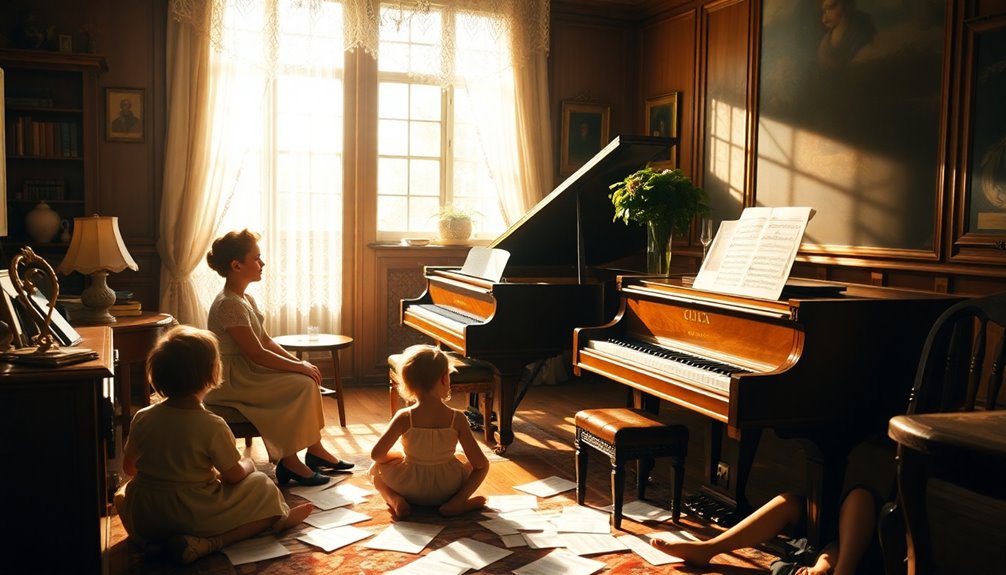
When you explore Mozart's marriage to Constanze Weber, you'll find a blend of romance and challenges. Despite facing financial difficulties and the loss of several children, their bond remained strong. This section reveals how their love endured through life's trials, shaping both their family life and Mozart's legacy. Their tumultuous courtship, marked by family opposition, ultimately led to a marriage that defied societal expectations.
Marriage to Constanze Weber
Mozart's marriage to Constanze Weber marked a significant turning point in both his personal life and musical career. Their relationship was not without its challenges, having faced opposition from family and a tumultuous courtship. After falling in love with Constanze in Vienna, they married on August 4, 1782, in St. Stephen's Cathedral, despite lacking initial consent from Mozart's father. The urgency of their marriage was driven by concerns over societal disapproval.
Here are some key aspects of their union:
- Courtship Struggles: Their relationship included brief breakups and jealousy, particularly influenced by family opinions.
- Financial Arrangements: The marriage contract specified financial terms, including 500 gulden assigned to Mozart and joint property.
- Family Opposition: Leopold Mozart's disapproval strained their relationship, leading to testy exchanges of letters.
- Musical Collaboration: Constanze's talents shone through as she performed in the premiere of Mozart's Mass in C Minor, highlighting their partnership. This performance was a testament to their connection, as it underscored Constanze's role as a trained pianist.
Despite financial difficulties, Constanze remained a steadfast supporter of Mozart's career, demonstrating her enduring love and commitment.
Family and Children
Throughout his life, Mozart's family played an essential role in shaping both his personal and professional journey. Born to Leopold and Anna Maria, he was the seventh child, with only his sister Nannerl and he surviving infancy. This close-knit family nurtured his exceptional musical talents from an early age, thanks largely to Leopold, a respected musician himself. He recognized Wolfgang's gifts when he was just four and guaranteed both children received extensive musical training. The family toured Europe, showcasing their skills and gaining influence from figures like Johann Christian Bach. Leopold's significant influence on Wolfgang's early musical development laid the groundwork for his future success.
After marrying Constanze Weber, Mozart continued this tradition of family involvement in music. Together, they had four children, though only Franz Xaver Wolfgang survived into adulthood. While Wolfgang guaranteed his children received musical education, none quite matched his extraordinary talent. The Mozart home offered a blend of music and moral education, creating an environment where creativity thrived. Through family correspondence, we glimpse their relationships and shared experiences, highlighting how foundational these bonds were to Wolfgang's development as a composer and individual.
Financial Challenges Together
Financial challenges marked the marriage of Wolfgang Amadeus Mozart and Constanze Weber, especially in the latter years of his life. Their extravagant lifestyle, paired with a lack of financial planning, led to significant struggles. High living costs, including a large apartment and an expensive private school for their son, exacerbated their financial woes. As debts to retailers and creditors piled up, Mozart's chronic overspending became a pressing issue, possibly linked to undiagnosed mental health conditions.
Despite these hardships, several factors shaped their financial landscape:
- Constanze's serious medical crises in 1788 drained resources, leading to expensive treatments.
- Mozart's fluctuating income, heavily reliant on commissions, suffered due to changing musical tastes and political turmoil.
- Friends and patrons often provided loans during tough times, which they repaid when commissions arrived.
- Constanze's management of Mozart's business affairs became vital, especially after his death, ensuring his legacy and financial stability.
Moreover, their strong bond amidst financial struggles served as a source of inspiration for Mozart's compositions, further enriching their shared life.
Through it all, the couple maintained a strong bond, supporting one another amid the chaos of their financial lives.
Notable Musical Works
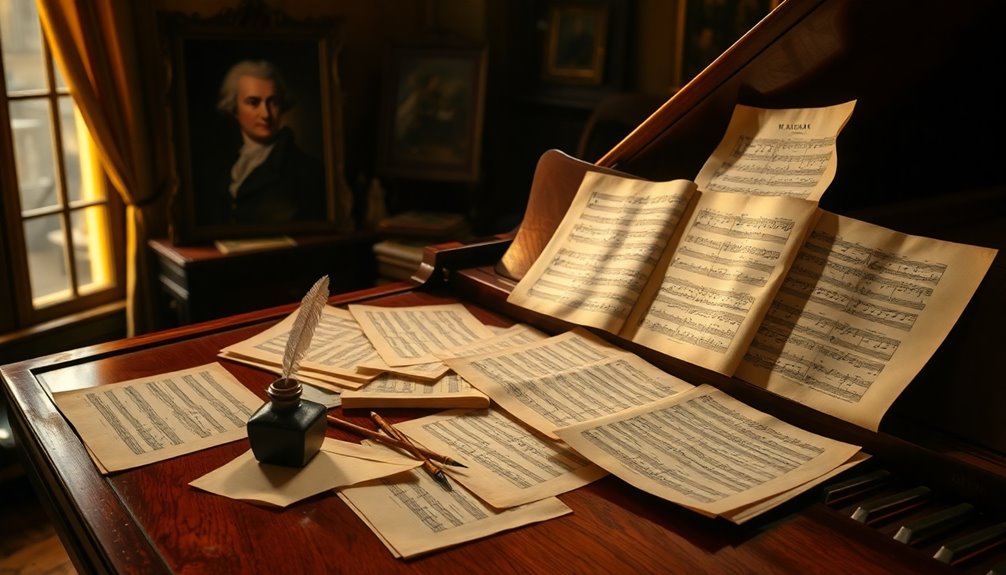
Wolfgang Amadeus Mozart's remarkable oeuvre includes a diverse array of notable musical works that continue to captivate audiences today. His operas, like *The Marriage of Figaro* and *Don Giovanni*, showcase his comic genius and deep character exploration. *The Magic Flute*, with its stunning "Queen of the Night" aria, remains a highlight of his operatic repertoire.
In the domain of symphonies, *Symphony No. 40* stands out for its tragic tone, while the *Jupiter Symphony* (Symphony No. 41) is celebrated for its intricate beauty. Each symphony reflects Mozart's evolving mastery of orchestral composition.
His concertos, particularly *Piano Concerto No. 21*, known as the "Elvira Madigan" concerto, and the *Clarinet Concerto*, are beloved for their lyrical melodies. *Eine Kleine Nachtmusik* is a popular serenade, offering delightful entertainment.
Among his other notable works, *Requiem in D Minor* holds a special place, with the Lacrimosa evoking profound emotion. Pieces like *Ave verum corpus* and *Exsultate, Jubilate* further showcase his exceptional talent for choral and solo compositions, solidifying his legacy as one of music's greatest geniuses.
Contributions to Classical Music
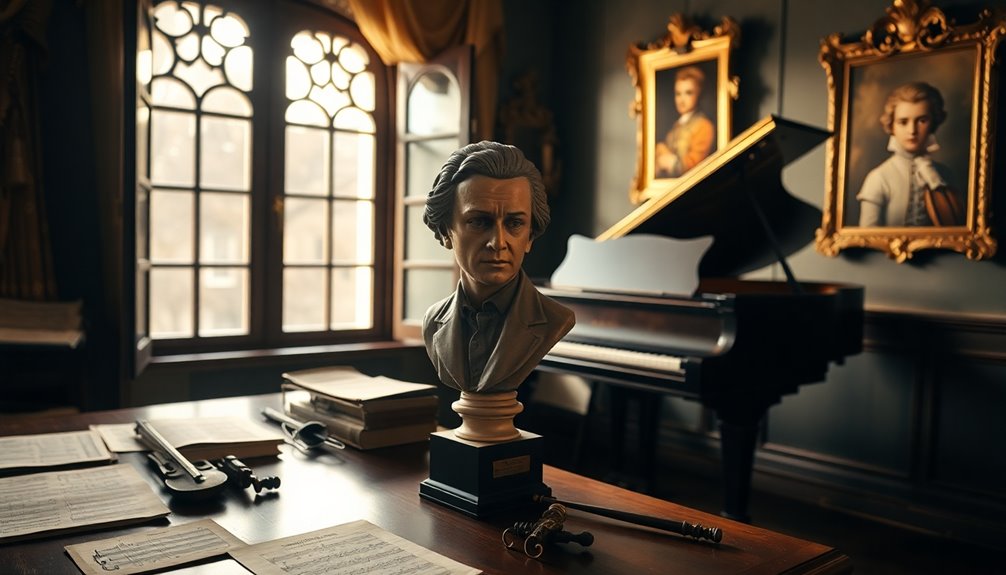
When you explore Mozart's contributions to classical music, you'll notice his innovative compositional techniques that transformed musical forms and genres. His influence on future composers is undeniable, as many looked to his work for inspiration in their own compositions. By blending technical mastery with emotional depth, Mozart set standards that continue to resonate today. His work in developing the symphony and concerto genres has had a lasting impact on the structure and style of Western classical music.
Innovative Compositional Techniques
Mozart's innovative compositional techniques greatly shaped classical music, showcasing his remarkable ability to blend creativity with technical prowess. His unique approach involved several key elements that set him apart from his contemporaries.
- Draft Scores and Sketches: You'll find that Mozart often created rough drafts, focusing initially on main melodies and harmonic structures. This process allowed him to refine his ideas continuously.
- Improvisational Skills: His prodigious ability to improvise was evident from childhood. You might be surprised to learn he could improvise fugally for hours, showcasing a mastery of complex forms.
- Manipulation of Form and Structure: Mozart pushed the boundaries of various musical forms, advancing the symphony, opera, and chamber music. His innovative use of key structures and harmony enriched the classical style.
- Creative Ideation and Inspiration: Ideas often struck him during walks or sleepless nights. You can see how he developed themes in his mind, allowing for a highly iterative and labor-intensive composition process.
These techniques highlight Mozart's extraordinary talent and his lasting impact on the evolution of classical music.
Influence on Future Composers
The innovative techniques that defined Mozart's work laid a powerful foundation for future composers, shaping the trajectory of classical music for generations to come. His mastery in developing grand forms, like symphonies and operas, set the standard for those who followed. Beethoven, for instance, was so inspired by Mozart that he copied passages from his symphonies into his sketchbook, illustrating the profound impact Mozart had on his contemporaries.
Composers such as Brahms and Schubert also drew from Mozart's innovative approaches, incorporating his techniques into their own compositions. His influence spanned genres, reaching Romantic, Modern, and Contemporary composers alike. Pieces like "Eine kleine Nachtmusik" and "Requiem" remain staples of the classical repertoire, showcasing the emotional depth and complexity that characterized Mozart's style. This harmonically sophisticated approach allowed future composers to explore richer emotional landscapes within their works.
Beyond composition, Mozart's music serves as an essential educational tool, helping students grasp musical structure and theory. His piano sonatas and symphonies are crucial in developing technique and ensemble skills. Fundamentally, Mozart's legacy continues to resonate, influencing not just the music of his time, but also shaping the future of classical music and education worldwide.
Later Life Challenges
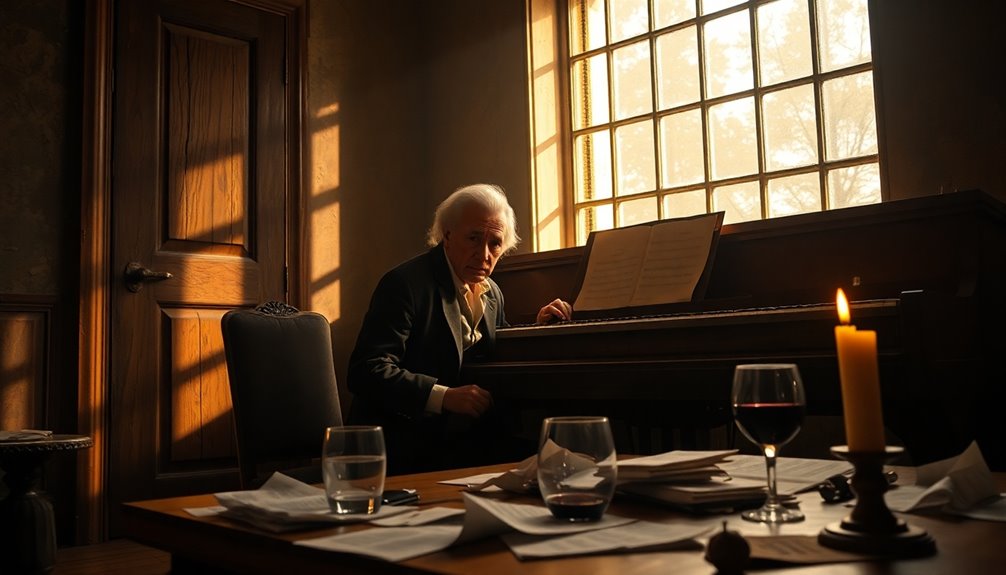
Throughout his later life, Mozart faced an avalanche of challenges that took a toll on his health, finances, and personal relationships. His persistent health issues stemmed from childhood illnesses and were exacerbated by his relentless work ethic. He often pushed himself into exhaustion, leading to severe symptoms during his final illness, which ultimately culminated in his death from severe miliary fever(severe miliary fever).
Financially, despite his talent, you'd find him struggling to make ends meet. A few key factors contributed to this:
- Loss of important patrons, like Holy Roman Emperor Joseph II, drastically reduced his commissions.
- His extravagant lifestyle left him with a constant need for money, forcing him to pawn possessions.
- The changing musical landscape diminished his performance opportunities, leaving him feeling lost and depressed.
- Personal relationships strained, especially after being blamed by his father for his mother's death.
These challenges weighed heavily on him, yet he managed to maintain a façade of joy in his private letters. Ultimately, it was a complex tapestry of health, financial instability, and personal strife that colored Mozart's later years, shaping the final chapters of his remarkable life.
Legacy and Influence

Facing numerous challenges in his later years, Mozart's legacy emerged as a powerful tribute to his genius. His unforgettable melodies, evident in works like "Eine Kleine Nachtmusik," resonate deeply with audiences, setting a standard for modern composers across genres. You can hear echoes of his melodic mastery in contemporary music, whether in films or popular songs.
Mozart's harmonic innovation pushed musical boundaries, inspiring jazz, rock, and electronic musicians to explore unexpected chord progressions. His structural brilliance created a model for balancing complexity and simplicity, evident in his symphonies and operas. This mastery has shaped the development of concertos and chamber music, showcasing his prolific output that laid the foundation for future compositions.
Moreover, his influence transcends classical music, finding its way into modern culture. You'll notice how his compositions are sampled and blended into diverse genres, enchanting new generations and introducing his work to a broader audience. The timeless quality of Mozart's music continues to touch hearts across cultures, proving that his genius remains relevant and powerful. In every note, you can trace the enduring impact of Mozart's creativity, a legacy that continues to inspire and uplift.
Frequently Asked Questions
What Was Mozart's Favorite Instrument to Play?
Mozart's favorite instrument to play was the viola. You'd notice his deep appreciation for its warm tone and unique role in chamber music, where it beautifully bridges the sounds of violins and cellos.
Did Mozart Have Any Pets?
Yes, Mozart had several pets, including dogs, canaries, and a famous starling. He cherished them, even holding a grand funeral for the starling, showing just how much they meant to him and his family.
Who Were Mozart's Musical Influences?
You'll find Mozart's musical influences were a tapestry woven from the likes of Bach, Handel, and Gluck. These luminaries shaped his style, enriching his compositions with diverse techniques and emotional depth throughout his extraordinary journey.
How Did Mozart's Music Evolve Over Time?
You'll notice Mozart's music evolves from simple early compositions to complex operas and symphonies. His innovative style reflects personal experiences, mastering various genres while continually pushing boundaries, showcasing his unparalleled creativity throughout his short life.
What Were Mozart's Hobbies Outside of Music?
Outside of music, you'd find Mozart enjoying billiards, cards, and horseback riding. He loved pets, especially birds, and frequently socialized at gatherings, indulging in charades, drinks, and his unique sense of humor.

